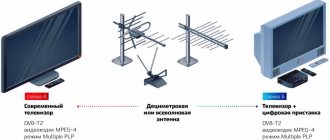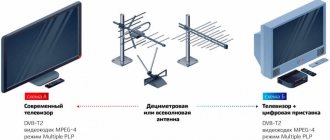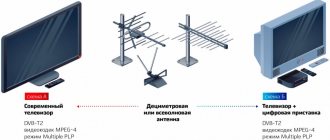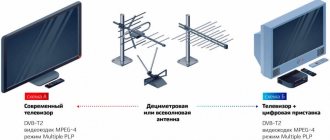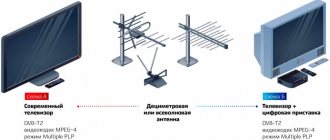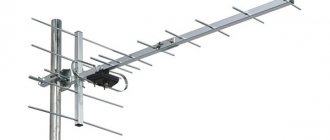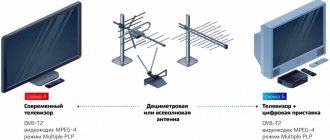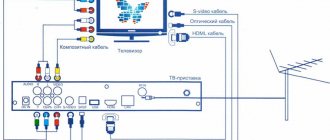How to set up and connect digital TV on a TV in Bryansk
Since January 2019, Russia and its regions have been switching from analogue to digital television signals in several stages. This allows you not only to improve the quality of image and sound, but also to increase the number of free channels. Finally, all settlements in Russia, according to information from representatives of the Ministry of Digital Development, Communications and Mass Communications of the Russian Federation, will be able to switch to digital before October 14, 2021. We will tell you what actions need to be performed at home or in the country when your region completely switches to digital TV.
In connection with the mentioned transition to digital broadcasting, those people who watch TV through an antenna, in some cases need to tune in to receive a digital signal. How can I tell if my television is digital or not? If, when you turn on the TV, instead of the usual TV programs you see a video about how to switch to digital, then you have analog television, and you need to perform a number of actions. The absence of an information video means that: you initially have digital television (satellite or Internet TV); you have terrestrial television, but the transition to digital broadcasting has already been completed; Do you have cable TV? The authorities agreed with cable television operators to preserve analogue broadcasting in the cable. But if you want, you can also switch to digital broadcasting in cable. Please note: if you have several TVs at home or in the country, they can receive a TV signal in different ways. For example, in the living room the TV is connected to cable TV, and in the kitchen the reception is via an antenna. How to set up digital TV at your dacha? Before the start of the summer season, we recommend that you find out in advance what type of signal the TV receives in your country house. If you have satellite TV, you don't need to do anything. But if you receive a TV signal using an antenna, prepare in advance to switch to digital TV. How to set up digital if I watch TV through an antenna?
If you have analogue television (there is an “A” next to the central channel logos), find out whether your TV supports the DVB-T2 standard. Digital TVs released after 2012 mostly have a corresponding decoder; those released earlier may not support this format (this is especially true for older analog TVs). You can check whether your TV supports the DVB-T2 standard in the instructions for the TV or using the “Search for information about TV” service on the website of the Russian Television and Radio Broadcasting Network (RTRS). You will need to enter the make and model of your TV. If your TV supports DVB-T2, you just need to set up your TV using the remote: Step 1: Turn off the TV's power. Step 2: Connect the antenna cable to the antenna input of your digital TV. Step 3: Connect the power and turn on the TV. Step 4. Go to the appropriate section of the TV settings menu and activate the digital tuner. Step 5. Automatically search for programs using the instruction manual. You can perform a manual channel search. In this case, you must enter the channel number or frequency. If your TV does not support this format, you need to purchase additional equipment - a digital set-top box (receiver). If you have two TVs that you watch through an antenna, and you want to watch different channels on them, you need to purchase a set-top box for each of them. The digital set-top box needs to be connected to the TV and configured: Step 1. Turn off the power to the TV. Step 2. Connect the antenna cable to the antenna input of the digital set-top box. Connect the video and audio cables to the appropriate jacks on your TV and set-top box. The image quality will be higher when connecting the set-top box to the TV with an HDMI cable. Step 3: Connect the power and turn on the TV. Step 4. From the menu, select the required input source: HDMI, AV, SCART and others. Step 5. Automatically search for digital TV programs using the operating instructions. You can perform a manual search. In this case, you must enter the channel number or frequency. You can also find more information on how to connect digital TV, choose a digital set-top box, where to buy it and how to set it up, on the website of the mentioned Russian Television and Radio Broadcasting Network (RTRS), where, depending on your region, you must call the hotline They will tell you how to troubleshoot possible problems. How can I retune my TV to digital if I have cable TV? If you have cable television and want to set up a digital signal, you need to: Step 1. Enter the menu using the special button on the remote control. Step 2. Go to the “Channel” section, which usually has a satellite dish icon. Step 3. Select "Auto search". Step 4. Select “Cable” from the proposed connection options. Step 5. Next, select “Digital” and click on “Start”. Step 6: If you want to keep the analog channels, select “Analog and Digital”. If you have any additional questions, you can contact your operator's support team. Please note: if you receive a TV signal through cable, but still see an informational video about switching to digital broadcasting, you will need to contact your cable operator's customer service and ask about how you can connect to digital TV within the current tariff. What channels will be available to me after switching to digital TV? If you watch television through an antenna, after switching to a digital signal, 20 mandatory TV channels of the first and second multiplexes will be available to you. The first multiplex includes: Channel One, “Russia 1”, “Match TV”, NTV, “Petersburg - Channel Five”, “Culture”, “Russia 24”, “Carousel”, OTR, “TV Center - Moscow”. The second multiplex includes: REN TV, Spas, STS, Domashny, TV-3, Friday!, Zvezda, Mir, TNT, Muz-TV). If you have cable television, you will have access to those channels that are provided for in your agreement with the operator. At the same time, by agreement between regional authorities and operators, more than 50 TV channels will be available in digital quality, the mos.ru portal reports. Earlier, the Ministry of Telecom and Mass Communications approved a plan for a phased disconnection from analogue television and radio broadcasting in the constituent entities of the Russian Federation as part of the transition to digital in December 2021. The switch-off from analogue broadcasting was decided to be divided into three stages from January to June 2021, namely February 11, April 15 and June 3. During the first wave of transition to digital, analogue TV was replaced in the Penza, Magadan, Ryazan, Ulyanovsk, Tula, Yaroslavl regions, as well as in the Chechen Republic. On April 15, another 20 Russian regions switched from analogue to digital television broadcasting. Among those who switched from analogue to digital TV were Moscow, Moscow region, Kalmykia, Mordovia, Karachay-Cherkessia, Chuvashia, Kabardino-Balkaria, Stavropol Territory, Udmurtia, Yamalo-Nenets Autonomous Okrug, as well as Kemerovo, Amur, Ivanovo, Kirov, Kostroma, Kurgan, Lipetsk, Novgorod, Sakhalin, Tyumen regions. It was planned that the transition process would end with the third stage on June 3, when the remaining 57 regions would be transferred to digital. However, the Russian government decided to extend this period and transfer the remaining regions of Russia to digital in October 2021. “The main task that continues to face all regions, regardless of whether they find themselves in the third or fourth stage, is to by June 3, all the necessary work was done. It’s just that residents of some regions that belong to the fourth stage, if fully ready, will receive analog television for some time,” concluded the deputy head of the Ministry of Telecom and Mass Communications. TOTAL, in October 2019, all regions of Russia: Adygea, Altai, Bashkiria, Buryatia, Dagestan, Ingushetia, Kabardino-Balkaria, Kalmykia, Karachay-Cherkess Republic, Karelia, KOMI, Crimea, Mari El, Mordovia, Sakha (Yakutia), North Ossetia (Alania), Tatarstan, TUVA, Udmurtia, Khakassia, Chechnya, Chuvashia, Altai Territory, Transbaikal Territory, Kamchatka Territory, Krasnodar Territory, Krasnoyarsk Territory, Perm Territory, Perm Territory, Primorsky Territory, Stavropol Territory, Khabarovsk Territory, Amur Region, Astrakhan Region, Arkhangelsk Region , Belgorod region, Bryansk region, Vladimir region, Volgograd region, Vologda region, Voronezh region, Ivanovo region, Irkutsk region, Kaliningrad region, Kaluga region, Kemerovo region, Kirov region, Kostroma region, Kurgan region, Kursk region, Leningrad region, Lipitskaya region, Magadan region, Moscow region, Murmansk region, Nizhny Novgorod region, Novgorod region, Novosibirsk region, Omsk region, Orenburg region, Oryol region, Penza region, Pskov region, Rostov region, Ryazan region, Samara region, Saratov region, Sakhalin region, Sverdlovsk region, Smolensk region, Tambov region, Tver region, Tomsk region, Tula region, Tyumen region, Ulyanovsk region, Chelyabinsk region, Yaroslavl region, federal cities - Moscow, St. Petersburg, Sevastopol, Jewish Autonomous Okrug, Khanty-Mansi Autonomous Okrug, Yamal-Nenets Autonomous Okrug, Nenets and Chukotka Autonomous Okrug - will switch completely to digital television.
03.05.2019 11:33
· Initial broadcast frequency - 770 MHz (770,000 kHz);
· The final broadcast frequency is not specified;
· Symbol rate - 6875 Ksim/sec;
· Modulation – 256 QAM;
Setting up Digital channels on SAMSUNG TVs.
Before setting up, you need to set the following parameters in the menu:
· Country – Slovakia, Slovenia or Others;
· Auto search for digital and analogue channels;
· Source – Cable;
· Search mode - Network.
What can you watch for free?
Two packages of domestic channels, which are called multiplexes. Another one, the third, can only be watched by Muscovites for a limited number of hours a day. However, in the future it is planned to open it to all Russians.
What's included in multiplexes?
- The first package, RTRS-1, includes nine news channels and one sports channel.
- RTRS-2 has ten TV channels with entertainment programs and films.
RTRS-1 and RTRS-2 are broadcast from towers to a house or apartment where there is a receiving antenna or TV.
To configure your TV to receive TV broadcasts manually, you first need to determine the multiplex broadcast frequencies for your city or region.
Common problems and their solutions
Channels are not picked up at all, “no signal”
In this case, you need to check:
- equipment for breakdowns (TV, antennas and connecting cable). If you discover a problem, you should contact a specialist;
- antenna adjustment. The UHF antenna is extremely sensitive to the vector of the incoming signal. In most cases, changing the orientation of the antenna helps;
- distance to the repeater and signal strength. This information is provided by the RTRS service. Most likely, your receiver is in a “dead zone” that is not covered by television broadcasts. Unfortunately, until new towers are installed, reception in this area is impossible. You will have to resort to satellite broadcasting, available anywhere open to the south;
- being in a radio silence zone. The passage of the signal may be hampered by a nearby natural object (hill, mountain, etc.) or a man-made obstacle (main walls and ceilings). The situation can be corrected by changing the position of the antenna (for example, installing it on the roof), which allows you to get out of the radio shadow. The second option would be to connect to another repeater located within a radius of 30-35 km.
Only part of the channels are caught
Here you need to check:
- setting up a broadcast from a nearby tower. It is necessary to configure each multiplex on a separate frequency manually;
- setting up the tuner in the system itself. A number of channels may not have been preserved. Repeated automatic or manual TV tuning will help correct the situation.
There were channels, but they disappeared
If the signal was previously received reliably, but then the channels disappeared, the reason for this may be:
- the appearance of new obstacles on the way to the antenna from the repeater. You need to explore the surrounding area using a reception map;
- technical problems with the repeater. It is customary to cover such events with the help of alerts, which can be found in the regional media, local forum or public page.
- antenna malfunction. When using collective, you need to contact the service company. If you are using an individual one, it is worth checking the position of the antenna cable for a break and the position of the antenna itself.
Weak signal
The reasons are similar to the case of a complete absence of signal:
- long distance between receiver and repeater. The only solution to the problem is to purchase a new active antenna capable of receiving weak signals;
- radio silence zone. The antenna position needs to be changed.
